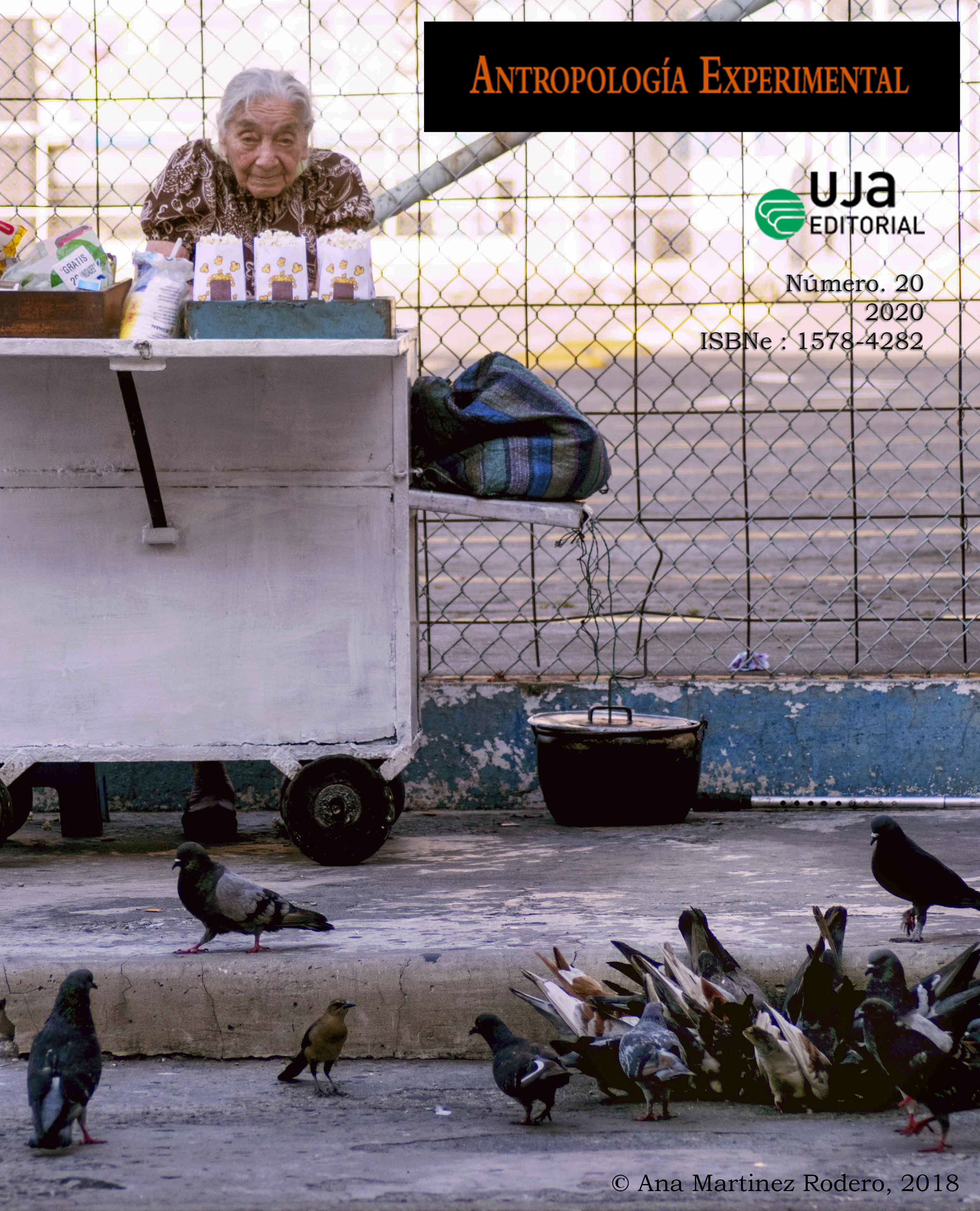Anthropology of the domestic
The kitchen, own territory and space for intercultural dialogue
DOI:
https://doi.org/10.17561/rae.v20.04Keywords:
Cooking, Cultural niche, Feeding, Interculturality, Dialogue, Intangible HeritageAbstract
On this essay, we show the key ideas to generate a discussion on domestic anthropology and thought born from tangible experience. The housework and crafts, skills and knowledge that persons use to their maintenance and welfare, supposes a useful knowledge to research the roots of culture built with other people. In this sense, cooking creates a unique social universe, related with the identification with territory, and really resistant in the assimilation process. We propose that cooking could be claimed like intercultural space. It constitutes by itself an intangible heritage, but also a frame where different cultures can join and share their way to understand the reality.
Downloads
References
ARSUAGA, L. MARTÍN-LOECHES, M. (2013) El sello indeleble. Random House Mondadori. Madrid, España. ARTUSI, P. (2010) La ciencia de la cocina y el arte de comer bien. Editorial Alba. Madrid, España.
ATENEO DE NAUCRATIS. (traducción de 1998) El banquete de los eruditos (trad. Lucía Rodríguez-Noriega Guillén). Editorial Gredos. Madrid, España.
BENEDICT, R (1989). El hombre y la cultura. Ed. Edhasa. Barcelona, España.
BORTOLINI E., PAGANI L., CREMA E., SARNO S., BARBIERI C., BOATTINI A., SAZZINI M., GRAÇA DA SILVA S., MARTINI G., METSPALU M., PETTENER D., LUISELLI D., TEHRANI J. (2017) Inferring patterns of folktale diffusion using genomic data. PNAS August 22, 2017. 114 (34) 9140-9145. https://doi.org/10.1073/pnas.1614395114
BREA, J. (2007) La Muerte de las lenguas: ¿Evolución, selección natural o genocidio cultural? Blog Global-Voices. 15/10/2007. Recuperado de https://es.globalvoices.org/2007/10/15/la-muerte-de-las-len-guas-¿evolucion-seleccion-natural-o-genocidio-cultural/
CAVALLI-SFORZA L.L. & FELDMAN M.W. (1981) Cultural Transmisión and Evolution; A Quantitative Ap-proach. Princeton University Press, Princeton, USA.
CORDÓN, F. (1980) Cocinar hizo al hombre. Editorial Tusquets. Barcelona, España.
DE GARINE I. (1999) "Antropología de la alimentación: entre naturaleza y cultura". Alimentación y cultura: actas del congreso internacional, La Val de Onsera, Huesca.
DE JORGE, D. Martín Berasategui: "La cocina no tiene fronteras, pero ha de tener raíces" JOT DOWN, octubre 2012 Recuperado de https://www.jotdown.es/2012/10/martin-berasategui-la-cocina-no-tiene-fronteras-pero-ha-de-tener-raices/
DURAN E. (1978) ¿Qué se entiende por igualdad? ABC Madrid. 11/01/1978. Recuperado de http://heme-roteca.abc.es/nav/Navigate.exe/hemeroteca/madrid/abc/1978/01/11/073.html
DYE L., HOYLAND A., LAMPORT D., LAWTON C. (2011) Meal Composition and Cognitive Function. In: Preedy V., Watson R., Martin C. (eds) Handbook of Behavior, Food and Nutrition. Springer, New York, USA. https://doi.org/10.1007/978-0-387-92271-3_36
FISCHER K, COLOMBANI PC, LANGHANS W, WENK C. (2001) Cognitive performance and its relationship with postprandial metabolic changes after ingestion of different macronutrients in the morning. Br J Nutr. 2001 Mar;85(3):393-405. https://doi.org/10.1079/BJN2000269
FLYNN, M., GEARY, D., WARD. (2005) "Ecological dominance, social competition, and coalitionary arms races". Evolution and Human Behavior, Vol. 26,1, 10-46, 2005. https://doi.org/10.1016/j.evolhumbehav.2004.08.005
GÓMEZ GARCÍA, P. (1993) Lo crudo, lo cocido y lo podrido: De las estructuras mitológicas a las culinarias. Anthropologica, Revista de Etnopsicología y etnopsiquiatría (Barcelona), 2ª época, 1993, nº 13-14: 91-111.
GÓMEZ-PINILLA, F. (2008) Brain Foods: The Effects of Nutrients on Brain Function. Nature reviews. Neuroscience 9.7 (2008): 568-578. https://doi.org/10.1038/nrn2421
GONZÁLEZ J.A., REIMANN F., BURDAKOV D. (2009) Dissociation between sensing and metabolism of glucose in sugar sensing neurones. Journal of Physiology. 2009, Jan 1; 587(Pt 1): 41-48. https://doi.org/10.1113/jphysiol.2008.163410
GUTHE, C.E., MEAD, M. (1945) Manual for the study of food habits. Bulletin of Natural Research Council, National Academy of Science, n1 111.
HARRIS, M. (1998) Antropología cultural. Alianza Editorial, Madrid, España. HARRIS, M. (1990) Bueno para comer. Alianza Editorial, Madrid, España.
HARRIS, M. (2011) Nuestra especie. Alianza Editorial, Madrid, España.
LEVI, E (s.f.) La comida kosher y el secreto del pueblo judío. Recuperado de https://es.chabad.org/library/article_cdo/aid/3288184/jewish/Shemini-La-comida-kosher-y-el-secreto-del-pueblo-judo.htm
LÈVI-STRAUSS C. (1964) El pensamiento salvaje, Fondo de Cultura Económica, México DF, México.
LÈVI-STRAUSS, C. (sobre un texto de 1965) "The Culinary Triangle". Food and Culture. A Reader. Ed. Carole Counihan y Penny Van Esterik. New York: Routledge, 2013 40-47.
LÈVI-STRAUSS, C. (sobre un texto de 1957) Sinfonía de los sabores. Recogido en El Correo de la UNESCO, nº 5, 2008. Recuperado de http://www.unesco.org/new/fileadmin/MULTIMEDIA/FIELD/Mexico/strauss.pdf
LOVERA, J.R. (2003) Acervo culinario y patrimonio cultural: Consideraciones históricas y propuestas políticas para Venezuela, Anales Venezolanos de Nutrición v.16 n.1 Caracas ene. 2003, Recuperado de http://www.scielo.org.ve/scielo.php?script=sci_arttext&pid=S0798-07522003000100006
MARINA, J.A., PELLICER C. (2015) La inteligencia que aprende. Santillana. Madrid, España.
NILSSON A, RADEBORG K, BJÖRCK I. (2012) Effects on cognitive performance of modulating the postprandial blood glucose profile at breakfast. Eur J Clin Nutr. 2012 Sep;66(9):1039-43. https://doi.org/10.1038/ejcn.2012.80
OVEJERO, F. J (2010). "Menú: lagarto y coco". Recuperado de www.sinislasdondenaufragar.wordpress.com.
PALANCO, N.M. (2009) Lenguaje y pensamiento. Contribuciones a las Ciencias Sociales. Recuperado de www.eumed.net/rev/cccss/03/nmpl5.htm
PANCORBO, L. (1994) Mi buen salvaje. Editorial Folio, Madrid, España.
PÁNIKER, A. (2014) La sociedad de castas. Religión y política en la India. Ed. Kairós. Barcelona, España.
PLATÓN (1983) Diálogos II (traducción de J. Calonge y otros). Editorial Gredos. Madrid, 1983. Recuperado de https://empezandoafilosofar.files.wordpress.com/2017/05/dialogos-de-platon_ii-1.pdf
REPOLLÉS-LLAURADÓ, J., ALEMANY SÁNCHEZ-MOSCOSO, V. (2013) La risa de fuego: Un análisis antropológico sobre el papel trasgresor del fuego en la creación artística. Arte, Individuo y Sociedad, 26 (1) 101-115. Recuperado en http://revistas.ucm.es/index.php/ARIS/article/viewFile/40894/41536. https://doi.org/10.5209/rev_ARIS.2014.v26.n1.40894
RIVAS, R. (2014) Come y calla… en Nueva York. Diario El País (edición digital). 21/02/2014. Recuperado en https://elpais.com/cultura/2014/02/21/actualidad/1393012103_327644.html
SELHUB E. (2015) Nutritional psychiatry: Your brain on food. Hardvard and Health Blog 16/11/2015 Recuperado de https://www.health.harvard.edu/blog/nutritional-psychiatry-your-brain-on-food-201511168626
SPENCER S., KOROSI A., LAYÉ S., SHUKITT-HALE B., BARRIENTOS R. (2017) Food for thought: how nutrition impacts cognition and emotion. Science of Food, Volume 1: 7. https://doi.org/10.1038/s41538-017-0008-y
Downloads
Published
Issue
Section
License
Responsabilidad de los autores: son responsables por las ideas y datos empíricos de los manuscritos, por la fidelidad de la información, por la corrección de las citas, por los derechos para publicar cualquier material incluido en el texto y por la presentación del manuscrito en el formato requerido por la Revista de Antropología Experimental. Un manuscrito enviado a la Revista de Antropología Experimental no debe estar publicado ni haber sido presentado en la misma forma a otro medio de publicación. Así, mismo, los autores reconocen que conocen y están de acuerdos con estas PAUTAS EDITORIALES Y FORMALES. La dirección de la Revista de Antropología Experimental está permanentemente abierta para aclarar cualquiera de los contenidos aquí citados u de cualquier otra índole que surjan en el proceso de publicación de los manuscritos.






